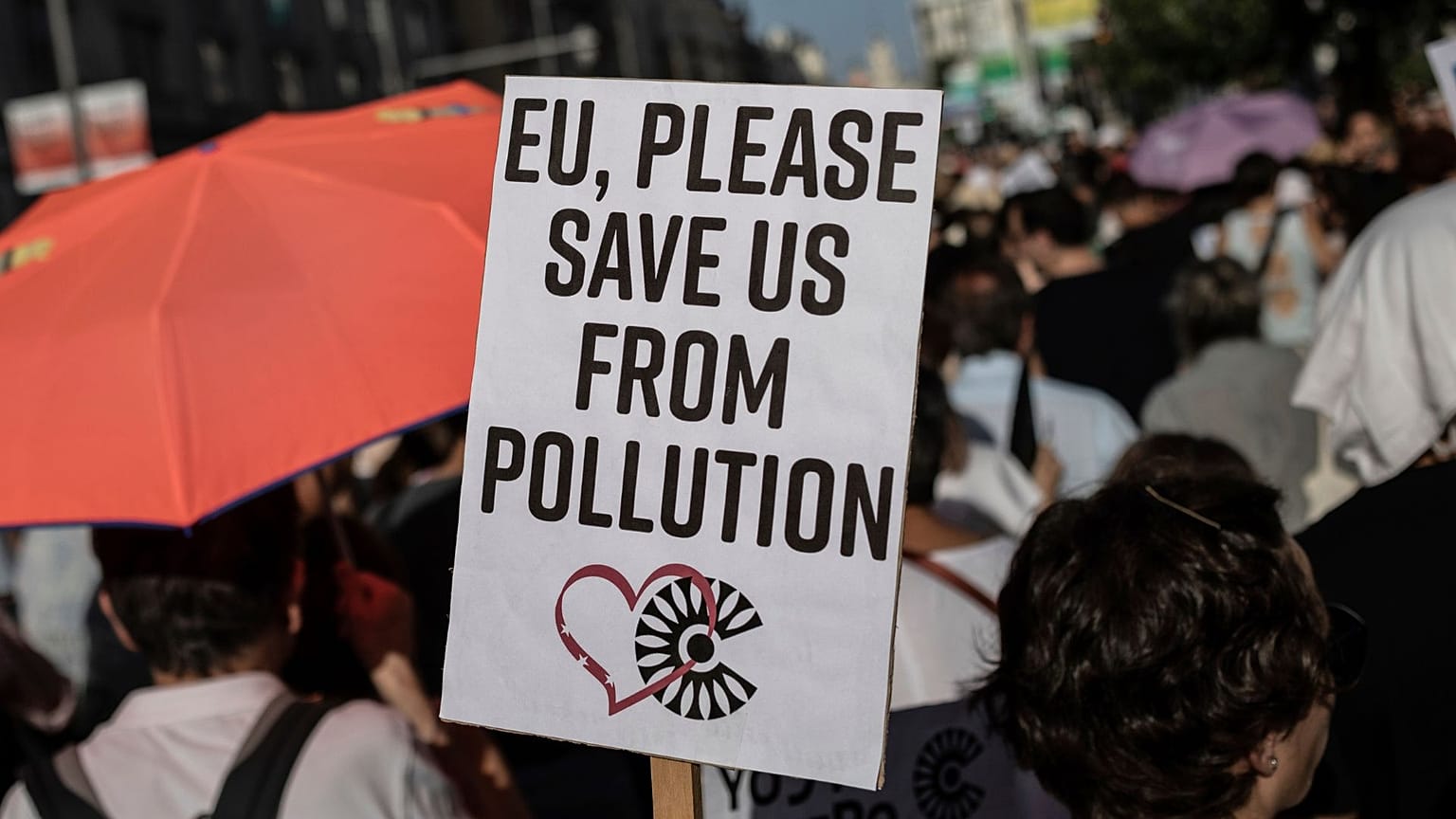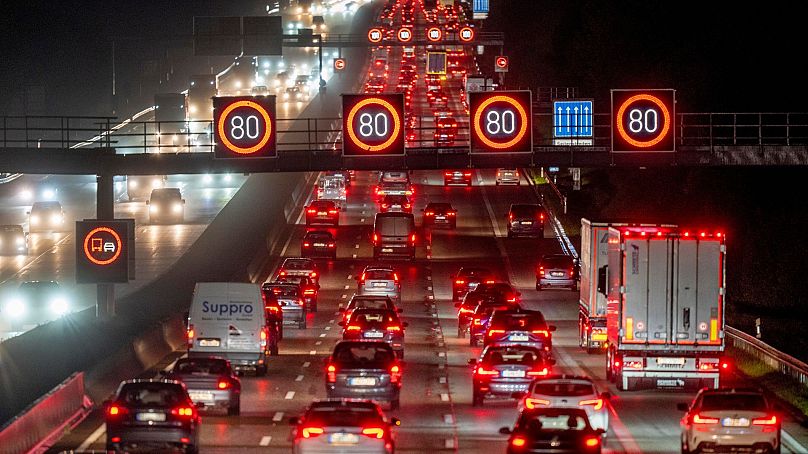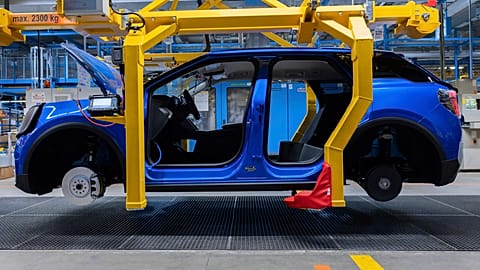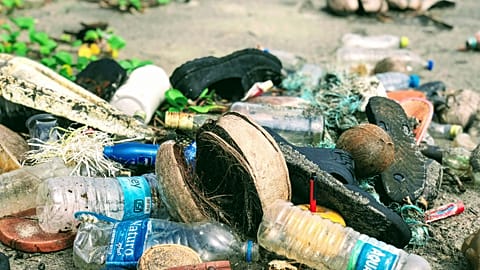Air pollution from cars is a silent killer in Europe. So why are emissions standards being weakened?
Air pollution in Europe remains well above healthy levels, according to a recent report by the European Environmental Agency (EEA). Road traffic is a major contributor.
This Thursday, EU member states and the European Parliament will meet to negotiate new legislation targeting urban pollution.
The ‘Euro 7’ standards aim to limit car emissions and help align EU pollution levels with World Health Organization (WHO) recommendations.
However, industry lobbying and political opposition threaten to weaken and delay the proposal.
Here’s why that could be disastrous for European citizens.
What is Euro 7?
Euro 7 is the upcoming revision to EU vehicle emissions standards, which aim to reduce the pollution generated by cars. The current Euro 6 rules set maximum limits for certain harmful gases and particulate matter produced by new cars and vans.
The new rules aim to regulate all vehicles - including lorries and buses - under one emissions standard.
They contribute to the European Green Deal’s target of achieving net zero greenhouse gas emissions by 2050.
Why does the EU need stricter vehicle emissions standards?
Combustion engine cars - especially those with diesel engines - release nitrogen oxides (NOx) into the air. These are rapidly converted into nitrogen dioxide (NO2), which causes 49,000 premature deaths per year in the EU, according to EEA.
It also indirectly contributes to the formation of fine particulate matter (PM2.5) which is even more harmful: the estimated number of excess annual deaths is 238,000.
Dense road traffic was linked to almost two-thirds of breaches of EU air pollution limits between 2014 and 2020. It also contributes 37 per cent of the total NOx emissions in urban areas, where 70 per cent of Europeans live.
To align with WHO recommendations, the EU needs to halve its NO2 and PM2.5 concentration limits - a goal the European Commission wants to achieve by 2030 under proposed revisions to Directive on Air Quality Standards.
Lowering NOx from tailpipes is essential to this - and the only way to achieve it is through robust Euro 7 standards, an impact assessment by the European Commission shows.
Also, the WHO limits for PM 2.5 (10 µg/m³ compared to the current 25 µg/m³ ) “can only be achieved with a reduction in NOx emissions from road transport”, explains Francesco Forastiere, epidemiologist and WHO consultant.
Why might Euro 7 standards be watered down?
In the run-up to the European Parliament elections in summer 2024, negotiations will take place to finalise both the Euro 7 standards and revise the closely interlinked Directive on Air Quality Standards.
Environment and public health defenders are readying themselves for disappointing results. So far, both proposals have been weakened through the European Council and Parliament votes in September and November due to industry lobbying and political opposition.
While the Parliament wants to postpone the alignment to the WHO guidelines to 2035, the Council recently recommended delaying it even further to 2040.
This decision does not come as a surprise. In September, the 27 member states adopted a watered down text on Euro 7 which will preserve NOx emissions at the current level. It will prevent significant reductions of NO2 concentrations in the short-term.
The version of Euro 7 tabled by the Council essentially continues with the almost 10-year-old Euro 6 norms for exhaust emissions. The only change is the introduction of limits for particulate matter from brakes and tyres and of on-board emissions monitoring systems to ensure long term compliance. Diesel-fuelled cars are still allowed to pollute more than petrol ones.
The Euro 7 text approved by the Parliament is slightly more ambitious. It partially maintains the requirements proposed by the EC, including the alignment of NOx emission limits for diesel to those set for petrol cars under Euro 6 (60mg/km) and tighter tests for the approval of new models.
Whatever the final agreement between the Council and the Parliament - the two EU co-legislators - on both the Euro 7 and the Air Quality Standards, it is unlikely to fulfil the public health improvements initially promised.
Car industry lobbyists go up against public health
Five years of taxpayer-funded expert work went into designing the most cost-effective regulatory framework to reduce road transport pollution.
But this work could be undermined by carmakers lobbying against a stringent Euro 7 Standard.
In 2015, the Volkswagen emissions scandal - sometimes referred to as Dieselgate - exposed the German automaker for falsifying emissions testing. Since then, the European Commission has put considerable human resources and funding into strengthening regulations.
Under a formal mandate from the Parliamentary Special Committee investigating the scandal, €3.9 million was spent on consultancy for the Euro 7 and the new Air Quality Standards. Over €80 million was spent on projects aiming to demonstrate that exhaust toxic emissions can be reduced by adopting already existing and affordable technical solutions.
However, the Council and the centre-right European People's Party (EPP) bloc in the Parliament have so far favoured business over public health.
“95 million new vehicles certified as Euro 7 will be sold until 2035,” says Anna Krajinska, manager of vehicle emissions and air quality at the NGO Transport & Environment.
“Without effective rules, [these] will be nothing more than greenwashed Euro 6 [vehicles] and many of them will keep poisoning our air for decades. Carmakers will claim they are cleaner and try to get them exempted from restricted access to city centres.”
Weakened Euro 7 could cost the EU €100 billion in damages
A weakened Euro 7 could cost EU citizens around €100 billion in health and environmental damages by 2050. This is due to excess pollution from vehicles sold before the combustion engine phase out in 2035, which will be allowed on the roads until the end of their lifetime, the Consortium for ultra-low vehicle emissions (CLOVE) found in an analysis carried out for Voxeurop magazine.
CLOVE, consisting of Europe's top academic, research and business specialists in the automotive sector, assisted the European Commission in the preparation of the Euro 7 proposal.
It came up with its estimates through scrutinising the weak text agreed by the Council, which is far below the targets proposed by the consultants.
In 2021 CLOVE experts outlined different policy options for the Euro 7 legislation. The options combined emission limits and test conditions for the approval of new car models, with different levels of stringency.
The costs and benefits of each policy were analysed through an impact assessment that CLOVE and the Commission jointly conducted ahead of the presentation of a legislative proposal in November 2022.
The policy that delivered the best balance called for €53 billion in technological upgrades, which car makers could pass on to consumers. These improvements would lead to environmental and health savings of €189.3 billion until 2050, giving an overall net benefit of €141.5 billion.
“Our cost-benefit analysis is based on transparent modelling assumptions and a thorough dialogue with all stakeholders,” says Professor Zissis Samaras, coordinator of CLOVE and co-founder of Emisia, which advises industry and policymakers on sustainable and cost-efficient transport technologies.
Euro 7 proposal doubles emission limits recommended by consultants
Eventually, the proposal presented by the Commission in November 2022 largely adopted the emission limits for cars recommended by the European Car Manufacturers Association, the Brussels-based industry powerhouse, which are double those advised by CLOVE consultants.
This paved the way to further weakening of the proposal.
In October 2022, a confidential presentation by the European Commission, seen by Voxeurop, offered a glimmer of hope. Although the proposal was weaker than CLOVE’s final recommendation, it delivered higher net benefits. The cost of technological upgrades was projected as €32.5 billion, with environmental and health benefits of €182 billion, giving an overall net benefit of €149.5 billion.
However, more realistic figures that that Voxeurop has confidentially obtained from trusted sources suggest that net benefits associated with the European Commission proposal would be as low as €133.6 billion. The compromise expected from the Council-Parliament negotiations could see this figure sink even lower, placing a heavy burden on citizens’ health.
A study by the research organisation International Council for Clean Transportation demonstrates that if the European Commission proposal were enforced in a timely manner in 2025, it would have cut at least 1 million tonnes of NOx emissions and prevented 7,300 premature deaths until 2050.
As a result of the industry’s time-wasting strategy and the delayed approval, the initial enforcement date of 2025 has been postponed to 2026/2027 for cars and 2028/2029 for heavy-duty vehicles. This extension alone may cause over 1,700 premature deaths in the EU.
This story is part of an investigation conducted with Voxeurop and supported by the Journalismfund Europe, the European Excellence Exchange in Journalism (E³J) and Free Press Unlimited.



















